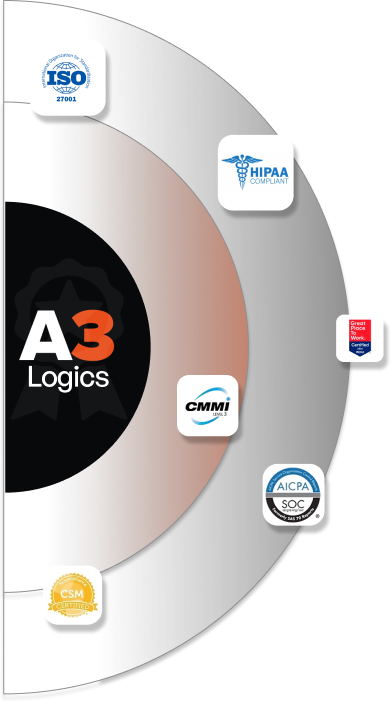Table of Contents
There’s been an astonishing increase in FinTech users, startups, and revenue. The global fintech industry’s revenue is increasing quickly, estimated to exceed 141.18 billion U.S. dollars in 2028. In addition, the number of people using digital payments is predicted to grow by 4.81 billion by 2028. The industry’s growth indicates an exponential growth in FinTech applications and suggests its potential to transform into a revenue-driven business. This guide will discuss the evolution and future of building a fintech app, key features, and cost estimation.
Evolution of Fintech Apps
The evolution of fintech apps can be broadly classified into 3 phases based on technological advancements and market changes:
Early Phase (2000-2010):
The initial financial applications were developed during this period to provide basic banking services on mobile devices, such as account balance checking, funds transfer, bill payments, etc. Fintech Apps like MoneyLion were developed to target specific mobile operating systems like iOS and Android.
Growth Phase (2010-2015):
With the rising popularity of smartphones, there has been massive growth in the building of fintech apps and investments. Statista said fintech startup deals grew from 80 in 2010 to over 1000 in 2015. Major innovations included peer-to-peer lending platforms like Lending Club and online investment apps like Robinhood, Robo Advisors, etc. Blockchain technology has also started being applied to develop cryptocurrency applications and exchanges. The top investment received startups included Stripe, Square, and Coinbase.
Next Generation Phase (2015-present)
This phase saw an exponential rise in next-gen financial technologies like AI, advanced analytics, biometrics, and augmented reality. Some examples include chatbots for customer support, AI-based robo advisors, and AR/VR for virtual banking. Business of Apps said investment in fintech startups reached over US$120 billion in 2020. Major innovation focus shifts to digital payments, personal finance management, alternative lending platforms, insurtech applications, etc. Top US-based hybrid mobile development companies like A3Logics are at the forefront of applying new technologies in developing financial apps.
How Does Fintech App Work?
Let’s deeply dive into how a typical fintech app works behind the scenes.
Frontend
The front end is the main interface where users interact with Apps like Afterpay. It uses leading mobile app development frameworks and SDKs that allow cross-platform development for iOS and Android ecosystems. Expert iOS and Android app development agencies apply strong UI/UX principles during design to create intuitive and engaging user experiences. Top mobile app development companies in the USA create and test interactive prototypes before deployment to refine the UI/UX.
Some key technologies used at this stage include React Native, Flutter, Xamarin, etc, for developing hybrid cross-platform apps. These solutions allow building once and deploying to multiple platforms, reducing costs versus native apps. Frameworks offer pre-built components, smooth animations, and cross-device compatibility for feature-rich apps. Design patterns followed ensure pixel-perfect imagery and brand consistency across platforms.
Backend
The backend is the centralized computing system that supports the frontend delivery. It involves architecting robust backend infrastructure using databases, APIs, web services, and servers. Popular technologies are Node.js, Ruby on Rails, Python/Django, PHP, etc. Databases like MongoDB, MySQL, and Postgres have been implemented to store massive customer and transactional data securely.
Core APIs power key backend operations. Payment gateway APIs like Stripe and PayPal are integrated to process payments and transactions. Identity management APIs handle KYC/AML compliance through eKYC services. Other financial network’s APIs enable deposits and transfers between accounts. Blockchain networks and APIs facilitate next-gen fintech innovations in areas like digital assets. Mobile application consulting services are vital in designing scalable and secure backend architecture.
Middleware
Middleware components manage the communication between the front and backend seamlessly. They process API calls from the app interface, retrieve data from databases/servers, parse responses into usable formats, and update records. Responsibilities include data validation, authentication, authorization, and caching. Popular open-source middleware options include Express.js, Django, Flask, Hapi, etc.
Functional Modules
Fintech Cash Advance Apps Like Empower incorporate sophisticated functional modules powered by algorithms and Advanced technologies. Key modules include account management, lending, payments, investment, cards/wallets, robust analytics dashboards, and personalized insights. AI/ML augments modules like robo-advisory wealth management with human-caliber intelligence. Features like P2P transfers use blockchain for transparency. Leading developers bring modules to life by building on their FinTech domain know-how.
Integrations
Third-party service Integration allows fintech apps to tap into the capabilities of major financial networks and providers. This includes the integration of payment gateways for local and global money movement, identity verification through KYC services, and credit scoring agencies for underwriting. Other areas include bank account access through open banking, remittances, loyalty programs, etc. Secured APIs delivered by expert fintech application development services form the backbone of such partnerships.
Advanced Technologies
Cutting-edge technologies deployed add uniqueness to fintech offerings. AI/ML powers personalization, risk assessment, and predictive analytics on consumer behavior data. Blockchain brings trust and security to digital transactions without intermediaries. AR/VR drives financial education through experiential learning. Biometrics via facial recognition enhances login security. Top AI Investing App Development company in the US, engineers deliver these innovations responsibly, leveraging their technical expertise.
Security
Information security is paramount in financial apps since they handle sensitive personal and financial information. Robust security practices implemented include multi-factor authentication, data encryption-at-rest and in-motion, monitoring of activities, and regular vulnerability assessments. Data governance ensures compliance with regulations like GDPR. Expert mobile application consulting services advise on security architecture aligned with industry best practices and keep apps protected through upgrades.
To summarize, seamless convergence of design, technology advancements, integrations, and rigorous security practices are the drivers in creating FinTech apps. When developed using the best tools and methodologies, powerful fintech experiences can be offered to users worldwide. A3Logics’s expertise in building scalable, secure, and compliant digital platforms powers top apps in the financial space.
Prepare for the Future of Fintech—Get Your App Now!
Steps of Building a Fintech App
Building a successful FinTech mobile application requires meticulous planning and execution following proven methodologies. Here are the key steps typically undertaken by top fintech app development companies in the USA:
Project Planning
The initial phase involves extensive requirements gathering and documentation in consultation with stakeholders – usually the client financing the project. This helps the mobile application consulting services comprehensively understand the target market, goals, features, timelines, and budgets. Project managers outline high-level architecture diagrams, workflows, and prototypes. Resource estimation for the backend, frontend, design, security, QA, etc, is done. Enterprise app development companies’ approach to weighing capabilities, costs, and timelines is decided. Legal and compliance needs are also discussed. This results in a structured project plan guiding subsequent phases.
Design
Design forms the critical early stage where solutions are conceptualized. Expert UI/UX designers at leading Android and iOS app development agencies start with competitor analyses and user research to model the design system. Wireframes, user flows, and site maps depict the information architecture and primary interactions. Visual design prototypes are made to align with the specified best practices and brand guidelines. They are refined based on reviews from multiple rounds of user testing facilitated by professional mobile application consulting services.
Prototype
Simple interactive clickable prototypes are built using tools like Figma and Adobe XD to demonstrate key features and workflows before development. Developers and stakeholders evaluate these low-fidelity prototypes for usability and alignment with requirements and identify areas for improvement. Necessary changes are incorporated. Prototyping helps eliminate rework at later stages. It paves the way for production-ready product delivery within estimated budgets and timelines when undertaken by top mobile app development companies in the US.
Development
Development is carried out iteratively in sprints, usually 2-4 weeks long, by an agile team of highly skilled engineers. The core tech stack is based on platform, features, scalability, and maintenance. A hybrid mobile development company often utilizes popular choices: React Native, Flutter, Xamarin, Python/Django, etc. Engineers at a USA-based company build modular, reusable, and optimized code adhering to best coding practices and architecture patterns. Work flows through automated pipelines involving version control, continuous integration, and deployment. Bugs are fixed on the fly, and changes are managed.
Testing
Quality experts form rigorous testing regimes to uncover flaws. Automated unit, integration, API, and UX tests are run during development. Manual testing types include functionality, compatibility, security, and performance testing. User Acceptance Testing (UAT) involves actual target users validating features. Cloud-based testing tools and open testing methodologies enhance testing efficiency. Regular audits ensure the app meets government data security and privacy guidelines, which experts from mobile application consulting services have implemented. Only bug-free versions are approved for production release.
Security Implementation
Information security solutions are integrated seamlessly as the product develops. Secured authentication using biometrics, multi-factor authorization, activity monitoring, and control mechanisms are incorporated. Sensitive user/financial data is encrypted at rest and in transit. Regular vulnerability assessments are conducted as per industry best practices. During deployment, security reviews are performed by security specialists in the USA.
Integration
Third-party financial service providers are integrated through their APIs/SDKs to enable core capabilities like payments, KYC, etc. Top mobile app experts ensure seamless integration design and execution to expected functional and non-functional standards. Partnerships with major players deliver rich out-of-box integrations.
Deployment
After thorough quality checks, the release management team deploys the production-ready mobile app onto relevant online marketplaces/app stores following mandatory submission processes. Monitoring systems track unexpected issues/bugs. App loading/performance is optimized for positive UX.
Support
Quality developer support and maintenance teams keep the live app running securely and smoothly. They resolve incoming user issues and manage timely updates and upgrades using a robust ticketing system. Best practices around code management prevent regressions. Support frameworks are designed to maximize customer satisfaction.
Analytics
To further optimize the app based on real user behaviors, analytics tools capture critical usage data, which experts from mobile application consulting services then analyze. Insights drive decisions around retention, segmentation, monetization, and product enhancements. Iterative data-driven improvements are made on an ongoing basis.
Marketing
Strategic marketing campaigns facilitate the large-scale acquisition of relevant target users and drive engagement. Channels may include social media promotions, influencer marketing, collaboration with distribution partners, and referral programs harmonized by professional communications specialists. Optimization keeps campaigns cost-effective.
Continuous Improvement
Great fintech apps remain relevant by continuously evolving to address emerging needs. The product and technology teams work on new updates regularly – from security fixes to innovative features – based on market changes, customer feedback, and competitive analysis. Timely execution of roadmaps keeps users attracted in the long run.
Following best-in-class development processes forms the backbone for launching industry-leading fintech solutions. Professional app development company methodologies lead to robust, scalable product deliveries within budget and timelines. This structured process ensures quality fintech product delivery when followed by top fintech app development companies like A3Logics.

Features You Must Include In Fintech App Development
Fintech mobile apps need to offer essential and differentiating features to deliver value. Here are some key features a successful fintech app should have:
- Account Management: Create and manage financial accounts and view transaction history and statements.
- Investment: Buy/sell stocks, mutual funds, cryptocurrencies. Access performance tracking and portfolio management tools.
- Lending: Apply for personal, business, or peer-to-peer loans with a seamless approval process with money lending app development.
- Budgeting: Create and track budgets and expenses. Get insights into spending patterns and categorization.
- Savings: Open recurring/fixed deposits and recurring transfers to long-term savings goals.
- Insurance: Purchase and manage policies like health, motor, and travel insurance directly or through aggregators.
- Cards: Issue and manage debit, credit, and prepaid cards alongside transaction and rewards details.
- Analytics: Understand trends through visualized dashboards and personalized financial insights.
- Security: Biometrics, 2FA login, activity alerts, and controls ensure foolproof protection.
- Integrations: Ability to directly use bank accounts or link existing wallets/cards/accounts.
- Personalization: AI-powered personalization of recommendations and offers based on individual needs.
When developed using cutting-edge tools by top app developers, these features deliver a highly engaging experience to users.
Cost of Building a Fintech App
The overall cost of building a fintech mobile app depends on various factors like-
Platform: The native iOS app costs more than Android initially but performs better. Hybrid solutions offer cost benefits but reduced capabilities.
Features: Simplistic apps with basic features have a lower budget than full-fledged ones involving complex modules.
Design/UX: Elaborate designs and animations to increase app development costs. Minimal design reduces costs.
Security: Implementing robust security practices like encryption and authentication adds to costs.
Developer Expertise: Top companies in the USA charge higher hourly rates than average developers.
Integrations: Integrating with multiple third-party APIs/services increases integration execution efforts.
Testing: Extensive testing procedures ensure quality but increase resource requirements.
Support: Ongoing tech support and maintenance inflate long-term costs post-launch.
Here is an estimated cost breakdown for a mid-sized fintech app with average complexity:
- Design and Prototyping: $5,000 to $15,000
- App Development: $30,000 to $50,000 for basic MVP. $80,000-$150,000 for a full-fledged app.
- Design/UX: $5,000 to $15,000
- QA and Testing: $10,000 to $25,000
- Security Implementation: $5,000 to $15,000
- Integrations: $2,000 to $10,000 per API
- App Store Compliance: $500 to $2,000
- Maintenance Per Year: 10-15% of development cost
- Upgrades/Version: 5-10% of development cost
The typical development timeline for an MVP ranges from 2-4 months based on team size and availability. Established custom app development services like A3Logics can effectively control costs and timelines through their expertise.
Future Trends in Developing Fintech Apps
Below are a few of the significant trends likely to influence the landscape over the next years:
Hyper-personalization
Fintech applications will more often utilize powerful tools like sophisticated AI analytics and AR/VR to provide highly personalized services depending on each client’s financial needs and behavior. Individualized insights, recommendations, and budgeting tools will become commonplace.
Embedded Finance
Financial services will be integrated into existing financial platforms and applications. For instance, you can access loans, buy insurance, or invest directly through the Internet, e-commerce, or social media streaming apps instead of dedicated banking applications.
Conversational and Embedded AI
AI virtual assistants and chatbots will provide seamless conversations for financial services. Customers can accomplish tasks just by talking to messaging platforms. Developing hybrid mobile app technology that allows omnichannel interaction is crucial.
Digital Assets & Crypto
As we progress with the infrastructure for blockchain and DLT, we’ll witness the widespread adoption of digital assets, such as crypto and utility tokens. Fintech applications will facilitate funds transfer and lending/borrowing against crypto assets. Technology like stablecoins could revolutionize cross-border transfers and remittances.
Regulatory Sandboxes
Countries are setting up regulatory sandboxes and frameworks to foster innovation responsibly. This will encourage many new players, especially in segments like insurtech, to test ideas securely before national rollouts. The app development agency‘s expertise in navigating compliance will be important.
Book 30 Minutes Free Consultations with A3Logics Experts to Start Your App Journey Today!
Final Thoughts
To conclude, the fintech industry has unprecedented growth opportunities led by advancements in emerging technologies. We are riding the biggest wave of digital disruption and innovation in the financial services domain. Fintech apps that leverage AI, blockchain, IoT, and AR/VR capabilities to intelligently address unmet needs will dominate the market. Top app development firms that embrace a design-thinking, customer-centric culture and emphasize security will succeed. Collaborations between startups and traditional institutions will likely reshape experiences. With financial inclusion and well-being driving policies globally, the scope for impact-oriented fintech ventures is immense. While uncertainties exist, the future remains bright for those who challenge the status quo with novel solutions. Skilled developers like A3Logics and strategic partners will be crucial in realizing this potential and ongoing progress.
FAQs
Q1. What are some popular categories of fintech apps?
Popular offerings include peer-to-peer payment apps like Venmo, robo advisory apps like Betterment, micro-lending best cash advance apps like Kiva, cryptocurrency exchanges like Coinbase, BNPL apps like Affirm, etc.
Q2. Which technologies are driving fintech app innovation?
Key technological forces include AI/ML, blockchain, augmented reality, biometrics, APIs, and cloud infrastructure. AI is powering advanced features like robo-advisory and fraud detection. Blockchain app development enables decentralized applications.
Q3. What are the challenges in building fintech apps?
Major challenges include navigating intricate regulations, securing customer money and data, building trust while innovating rapidly, acquiring and retaining users, high development and compliance costs, reliance on third-party services, privacy, and ethical issues with advanced technologies.
Q4. How can a fintech app monetize?
Common monetization models include – charging subscription/membership fees, earning transaction/percentage fees, premium features through in-app purchases, payment processing fees from merchants, selling customer data insights to other firms, lending/investing user balances for margins, and promoting and earning from other financial products.





